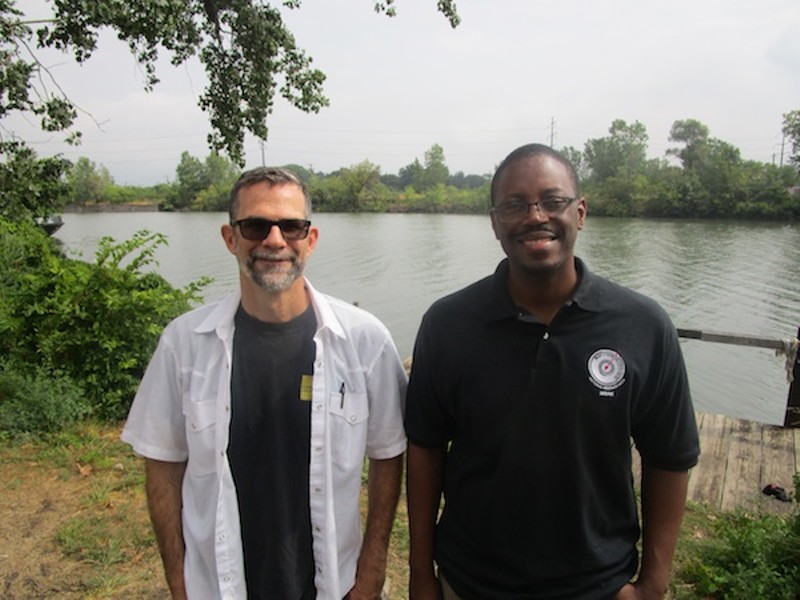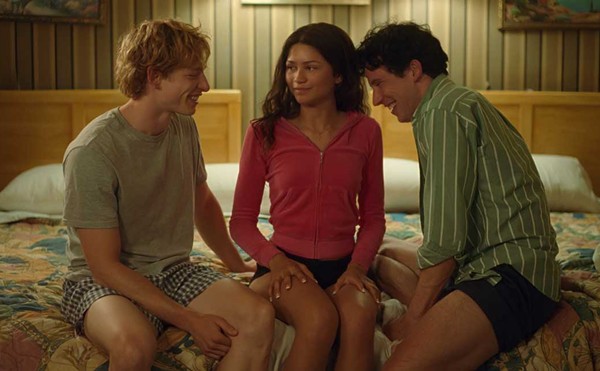
Photo by Michael Jackman
Paul Draus and Brian Yopp stand where they hope to see a park along the Rouge River.
Along Fort, just down the road from the new tower at Marathon Refinery as part of its $2.2 billion expansion to process tar sands oil, people might be jarred to take in the changes over the last 10 years. The Fort Street Bridge is working now, remade into a $50 million bascule bridge crowned with an impressive and otherworldly overhead counterweight. A sign identifying the bridge as the starting point of the 1932 Ford Hunger March, which ended with about a half-dozen people shot to death, is now missing. Another longtime landmark, Brian’s Bridge Café, famous for its red and green neon sign advertising “FRESH BOOZE,” is now a dirt lot.
In fact the whole neighborhood on two blocks near the bridge has disappeared. The homes in the shadow of the refinery, long saddled with the dubious distinction of being part of the state's most polluted ZIP code, have been bought out and razed, and the field where they stood is now a sort of environmental buffer zone that Marathon is rebranding as Oakwood Heights.
A decade ago, as you traveled upriver along the bank, the dilapidated homes and overgrown trees gave the neighborhood the feeling of being along the Mississippi Delta, an impression only heightened by the boats docked along the river's edge. Those boats, and several of the homes, do remain, although the foliage is much tamer. In fact, the former blocks near Fort Street are now fields of evenly cut turf, and refinery guards patrol the area to ensure there's no dumping or crime. While we're there, in fact, they stop to quiz us for a moment about why we're there.
As it turns out, we're there to learn more about a park on the riverfront designed to bring in people for recreation. If that sounds weird, consider that the bridge is part of the statewide Iron Belle bike trail, or that the Rouge River has improved in quality so much that kayakers and canoeists now enjoy plying its waters. With a little more funding and some serious elbow grease, the former site of Brian's Bridge Cafe will be an interpretive nature park, with sculpture, a kayak launch, a boardwalk, a rain garden, and a bioswale to help purify runoff from the buffer zone.
Our two hosts are Brian Yopp, of Motor Cities, and Paul Draus, a professor at the the University of Michigan-Dearborn, which has an ongoing commitment to the Rouge River watershed. As they tell it, the park has an unusual jumble of justifications designed into it. All of them make sense, and help supply partners and funding, but they do make for a tangle of ironies. Supplanting the historical marker for the Ford Hunger March, the park will gain funding from Ford Motor Company, which now notes its own role in that lopsided showdown 85 years ago. As an environmental buffer for the refinery, it will receive funding from Marathon, which specializes, of course, in some very dirty work.
The park is to include environmental education components, such as a pedal-powered fountain, helping it earn funding from the Erb Family Foundation. To get buy-in from the community, organizers are hosting fund-raising parties in the vicinity, and hope the park will be a gathering place for the hardy souls who remain in the neighborhood along the river. Then with the cycling trail and the recreation on the river, the Detroit Greenways Coalition and the Friends of the Rouge have become eager partners, along with Greening of Detroit and the local chapter of the Sierra Club.
“It’s a lot to try to do in a half-acre,” Draus says with a laugh. “I think when people see it, they’ll really get it.”
There's plenty working in the project's favor. The corner is owned by MDOT, which used it as a staging are for the reconstruction of the bridge. The polluted soil has been removed and untainted dirt has been put down. And though it's the most heavily industrialized part of the river, it's the site of one of the most popular and unusual water tours in metro Detroit, the “Paddle the Rouge” tours, which marks a 12th anniversary this coming month (the kayak tour is already sold-out, but the canoe tour still has some openings). The tour’s organizers have their eye on the planned park as stop-off point on planned water trail from Canton to the Detroit River.
It's part of an ongoing reversal all across Detroit. It used to be that the Motor City's industry hogged the waterways early and manufactured cars so Detroiters could drive far away to enjoy distant nature. Now, automotive companies are reorganizing, and formerly industrial sites are freed up so people can recreate right at home.
As Draus points out, “There are still residents here who have decided to stay.”
Yopp adds, “And all of a sudden they’re living near a park now.”
The appeal of the park will be a mix of green and blue infrastructure alongside scenes of industrial might. The two describe how great ships come through the narrow channel. “It’s quite a sight to see,” Draus says. “You can almost lean out and touch the freighters as they pass by.” The two think it adds to the attraction of the park, much in the same way visitors to Belle Isle enjoy watching the iron ore ships slip by.
The park’s backers have raised about half of the $600,000 they’ve budgeted for the park, now they’re looking for the other half. They’re proud that much of that money is coming from locals. Yopps says that many of the neighbors "have been on board since the beginning. ... Part of the fundraising that got us to this point were small donations at local fundraisers.”
In fact, another fundraiser is coming up in a few weeks at the historic club nearby: Carbon Athletic Club. They’re hoping people will show up at 1 p.m. for a ride across the Jefferson Avenue bridge, through River Rouge and Detroit’s most polluted ZIP code, and then back across the Fort Street Bridge. They’ll be back at Carbon A.C. by 2 p.m., where a party with music, fun, and generous donations will help the park break ground, hopefully by Spring of next year.
You can join supporters of the Fort Street Bridge Park at 1 p.m. for a bike ride or at 2 p.m. for a party on Sept. 16, at Carbon Athletic Club, 111 Gates St., Detroit; 313-554-3518.






